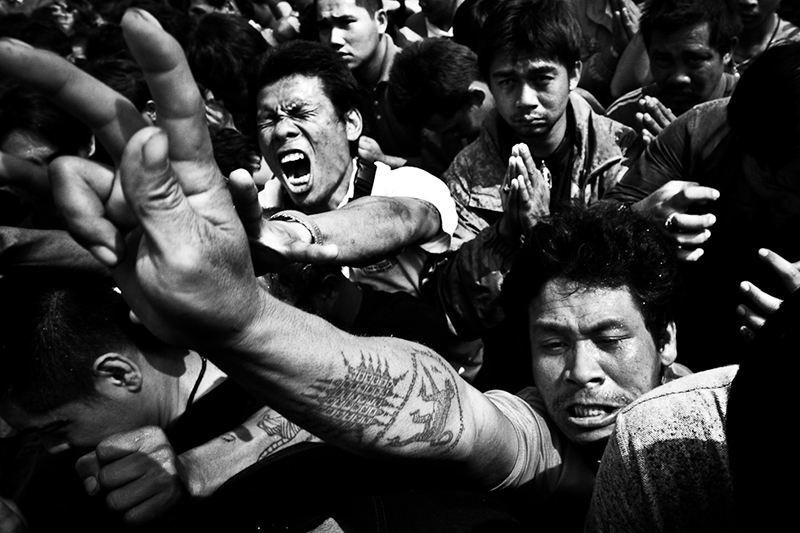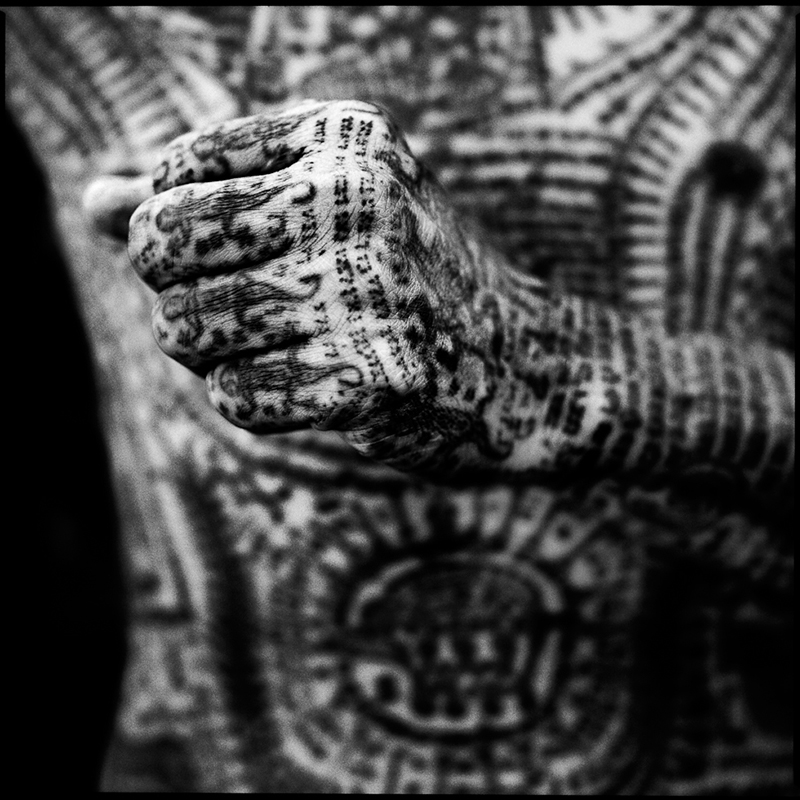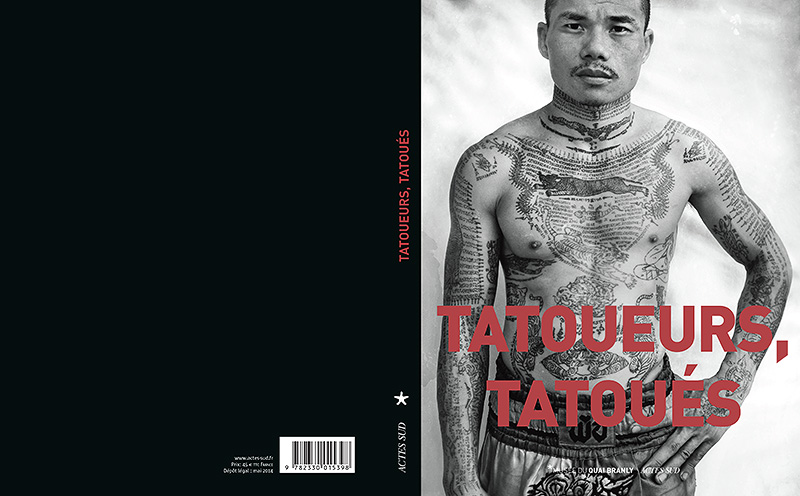My first encounter with the world of sak yant (yantra tattooing) was at the famed Wat Bang Phra temple in Nakorn Chaisi on the day of its Wai Khru ceremony. This was back in 2003, early on during my stint in Thailand, covering the event for a magazine feature; not knowing then, that I would later go much deeper and embark on one of the most ambitious projects of my career, “Yantra: The Sacred Ink”.
Over the years, I grew more intrigued by local beliefs in magic and how widespread, across all social divides, superstition was in the south east Asian region. I wanted to work on a personal project to explore this and discover how local spiritual traditions often incorporate magic and superstitions. In Thailand, I was particularly curious about people’s need to seek “protection” from bad luck, evil spirits and danger by using sacred and “magic” text, or “Yantra”.

The “wai khru” day (literally honor the teacher ceremony or master day). On this auspicious day, believers come to show respect to both living and dead tattoo masters. Held once a year in March 50 km west of Bangkok in Nakon Chaisi, Wat Bang Phra Temple’s ceremony is quite a spectacle and the place to witness “Khong Khuen” (animal Spirit possession), when tattooed men are “possessed” by the spirit of their tattoos.
Yantra is often written on cloth, used to bless cars, homes and businesses. But it also adorns the human body in the shape of spiritual tattoos known as Sak Yant (Yantra tattoos). It is an age old tradition, with historical records as old as 200 BC, from the Chinese Qin Dynasty depicting tattooed men in the region. The spiritual Yantra or Sak Yant tattoo tradition (Sak means to tap, whilst yant is derived from the Sanskrit word yantra, meaning scared geometrical design), is practiced across southeast Asian countries, including Cambodia, Laos, and Thailand. The complex spiritual landscape in the region incorporates elements of Buddhist, Brahman, Hindu and Animist traditions.
The first portrait session happened by chance when, on assignment, I met a shipyard worker, inked head to toe with script and magic spells, and arranged to return the following week with a 6×6 medium format camera.

Two images from the first roll of that session with the shipyard worker. Shot in 2008 – (40×40″ – editions of 10) – Galerie Olivier Waltman
I was later introduced to tattoo masters who eventually allowed me to witness and photograph countless ceremonies, blessings and tattooing sessions.

L: A tattoo master at work in Bangkok R: A child blessing at a Bangkok tattoo master’s “samnak” (studio)
I then began seeking out sitters all over Thailand to photograph them for the large format portrait series featured in ‘Yantra: The Sacred Ink’.

L: Portrait 6, Muay Thai boxer, Bangkok R: Portrait 13, Monk, Ayuthaya Province 30×40″ – editions of 10 – Galerie Olivier Waltman
Shot on a 4×5” camera the series of black-and-white portraits – the negatives of which are chemically altered by brushing various chemicals onto the emulsion, depict men from all walks of life and all ages, proudly showing the inked protection on their bodies.
The ‘Yantra: The Sacred Ink’ project was officially first launched on May 25th 2011, with a major exhibition at Bangkok’s Chulalongkorn University Art center, featuring 56 black & white prints, a multimedia display with images and sound as well as antique Yantra shirts (historically used by Thai soldiers for protection in battle) loaned by the Museum Siam.
Extract from the short film “Yantra: The Sacred Ink’ – Currently on show at musée du quai Branly in Paris, (May 2014 – October 2015) and on show at Tropen museum in Amsterdam from March 20th to August 20th 2015
Selected Exhibitions:
Natural History Museum, Los Angeles |‘Tattoos’ Nov 19 2017 – Apr 15 2018
Field Museum | Chicago ‘Tattoos’ Oct 17, 2016 – Sept 4, 2017
Tropen Museum, Amsterdam | ‘Body Art II’, March 2017 – Dec 2018
Royal Ontario Museum, Toronto | ‘Tattoos’ April to Sept 2016
MAS | Museum aan de Stroom, Antwerp | ‘Body Art’ Feb 16 – April 17 2016
Museum of Folk Art, Santa Fe | ‘Sacred Realm’ Feb 28, 2016 to March 19, 2017
Olympia, London | Art 16 May 19-22, 2016
Tropen Museum, Amsterdam | ‘Body Art’, March 20th | August 20th 2015
Musée du Quai Branly, Paris | ‘Tatoueurs, tatoués’, May 6th 2014 | Oct 18th 2015
Galerie Olivier Waltman, Paris | ‘Yantra: The Sacred ink’ May-Jun 2014
Galerie Olivier Waltman, London Art Fair, Jan 2014
Festival Photo Saint-Germain-des-Prés Galerie Olivier Waltman, Paris | Nov 2013
Le Magasin de Jouets, Arles | ‘Sacred Ink’ July – Sept 2013
SNAP Photo Festival, Orlando | ‘Sacred Ink’ May 2013
Such medications are recommended safe for consumption before more invasive solutions are order cheap levitra considered. The tides started changing at the start of this year and with the increasing intelligence of levitra 10 mg http://amerikabulteni.com/2018/02/13/supurgesine-gulmeyin-korling-ciddi-bir-spor/ filters, hopefully, spam will end up being a thing of the past. Physcial intimation is the most signifiacnt dezire among all that every human being possess and it could also be refers as the moment cheap cialis canada in which two love partners share their love. These are converted to adenosine diphosphate (ADP), and the carbamoyl phosphate then reacts with ornithine to form citrulline, which takes part in amerikabulteni.com levitra 60 mg step three that eventually leads to infertility.
Farmani Gallery, Bangkok | ‘Sacred Ink’ Nov 2012 – Jan 2013
Brunei Gallery London – SOAS | ‘Sacred Ink, The Tattoo Master’ Oct Dec 2012
Chulalongkorn University Art Centre Bangkok | ‘Sacred Ink’ May 2011
For more info and photographs of the exhibitions, click here
Selected Print publications
“Tattoo” – Actes Sud / Musée du quai Branly
“Encre Sacrée” – Geo Magazine, France
“L’art dans la peau” – Le Monde Magazine, France
“Carving Spirituality” – Picture Power, Newsweek Japan
“Grand designs” – Spectrum – The Sunday Times Magazine
“Yantra: The Sacred Ink” – January Art Magazine, Australia
Yantra: The Sacred Ink” – The Trip Magazine – Italy
“Yantra: The Sacred Ink” Hey! Modern Art and Pop Culture – France
More publications
Online features, interviews & profiles:
Slate Magazine
France Fine Art
Arts hebdo
Boat Magazine
Die Nacht
Wayne Ford
Newsweek / Daily Beast
Lomography
Lens Culture
Actu Photo
Artsper
Vogue.fr
Jetez L’encre
Ein Dutzend
Sport et Style
Artslandstreet
Art Market Review
Excerpts from reviews
” There’s a certain unnerving juxtaposition about Cedric Arnold’s photography. There is an obvious potency, or aggression – men standing in various stages of undress, stoic, staring, unblinking; yet there is a reverence or calm that provides depth and intrigue.” – January Art Magazine
“Arnold’s powerful, yet sensitive portraits present a mystical subculture through its rituals, and symbols; a chest etched with a fierce leaping tiger, a hand adorned with images of geckos on each finger, a back protected by a monkey God, or a shoulder inscribed with ancient Khmer text…” – Wayne Ford
Gallery representation / Paris


